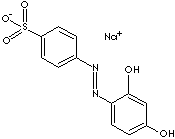PRODUCT IDENTIFICATION
11.1 - 12.7

Acid Dye, pH Indicato
Stain, Coloring Agent
c1(\N=N\c2c(cc(O)cc2)O)ccc(S(=O)(=O)[O-])cc1.[Na+]
EXTRA NOTES
Other RN: 111886-17-0
PHYSICAL AND CHEMICAL PROPERTIES
REFRACTIVE INDEX
EXTERNAL LINKS & GENERAL DESCRIPTION
USA.gov - Tropaeolin O
Wikipedia Linking - Chrysoine resorcinol
Google Scholar Search - Tropaeolin O
Drug Information Portal (U.S. National Library of Medicine) - Tropaeolin O
PubChem Compound Summary - Tropaeolin O
IPCS INCHEM - WHO FOOD ADDITIVES SERIES NO. 12
KEGG (Kyoto Encyclopedia of Genes and Genomes) - Tropaeolin O
http://www.ncbi.nlm.nih.gov/ - Tropaeolin O
Material Safety Data Sheet - Tropaeolin O
EPA - Substance Registry Services - Tropaeolin O
Local:
Acid dyes are water-soluble dyes employed mostly in the form of sodium salts of the sulfonic or carboxylic acids. They are anionic which attach strongly to
cationic groups in the fibre directly. They can be applicable to all kind of natural fibres like wool, cotton and silk as well as to synthetics like polyesters, acrylic and rayon. But they are not substantive to cellulosic
fibres. They are also used in paints, inks, plastics and leather. Orange acid azo dyes produce an orange-pink color. They are used in coloring foods and drugs and as intermediates for making photosensive dyes and drugs. They are used as counter stains in histology and cytology and as components of Mallory's acid fuchsin. Acid Fuchsin (acid magenta) is a various mixture of sulfonated fuchsins. There are four of these compounds which have three sulfonic groups each. It is used in Andrade's indicator and in various complex stains to demonstrate collagen fibres red and in smooth muscle in contrast to collagen. It is used as a pH indicator.
Examples of orange acid dyes
- Ethyl orange Sodium salt ( CAS RN: 62758-12-7)
- Orange II ( CAS RN: 633-96-5)
- Orange III (methyl orange, CAS RN: 547-58-0)
- Orange IV (CAS RN: 554-73-4)
- Orange G ( CAS RN: 1936-15-8)
- Tropaeolin O (CAS RN: 547-57-9)
- Victoria orange
- Acid Orange II (Dibromofluorescein, 596-03-2)
Tropaeolin O is called chrysoine resorcinol when used as a food additive (E number E103) and called tropaeolene as a biological stain. Tropaeolin O is used as a pH indicator from pH 11.1 (yellow) to pH 12.7 (orange).
APPEARANCE
11.1 (yellow)
12.7 (orange).
MOISTURE
5.0% max
HAZARD OVERVIEW
Not a dangerous substance according to GHS. Eyes: May cause eye irritation. Skin: May be harmful if absorbed through skin. May cause skin irritation. Inhalation: May be harmful if inhaled. May cause respiratory tract irritation. Ingestion: May be harmful if swallowed.
RISK PHRASES
SAFETY PHRASES